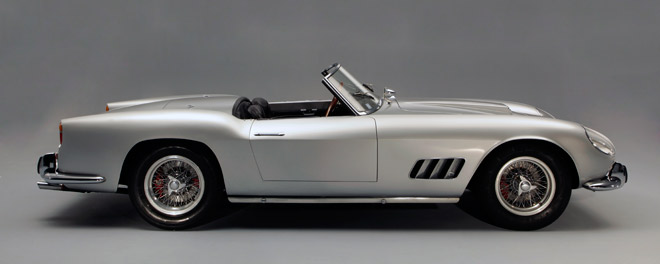SCM Analysis
Detailing
| Vehicle: | 1959 Ferrari 250 GT LWB California Spyder |
This car, Lot 378, sold for $5,931,349, including buyer’s premium, at Artcurial’s Rétromobile Auction in Paris on February 3, 2012.
Roger Vadim lived a life James Bond would envy. He was the privileged scion of a French diplomatic consul and a French actress. When he was 22, he met and later married Brigitte Bardot. Although they soon were divorced, it was not before he made a movie — “And God Created Woman” — with Bardot that made him wealthy.
Before his death in 2000, Vadim would make more than 30 feature movies. One project was a book: Bardot, Deneuve, Fonda: My Life with the Three Most Beautiful Women in the World. Vadim was, at different times, married to both Bardot and Jane Fonda. He also had a child with Catherine Deneuve, married two more stunning women, and enjoyed the company of a list of starlets.
One wonders how Vadim found time to drive, but he owned a succession of sports cars, which he used to navigate Europe from his home in Saint-Tropez. Among his cars were two Ferrari California Spyders, 1283GT (our subject car) and 2175GT. Bardot’s name is sometimes associated with Vadim’s Ferraris, but the couple was divorced before he got his first California. Bardot once owned California 0937GT, but again, this was after the divorce.
1283GT was a relatively early California that was originally fitted with drum brakes. Not long after it was delivered, Ferrari upgraded the model to disc brakes, and Vadim returned his car to the factory for the change.
Circling back to another filmmaker
In 1993, Symbolic Motor Car Company bought the car. Symbolic, in turn, sold the car to a French dealer, Jean Guikas.
It would take Guikas four years to sell the car, but, when he did, Jean Claude Bajol, another French filmmaker and Ferrari enthusiast, was the new owner. The story goes that, as a youth, he had met Vadim and had gotten a ride in Vadim’s 1283GT California. That ride may — or may not — have fueled his passion for Ferraris, but he eventually bought 1283GT.
Bajol treasured his acquisition and kept it until his death in 2011.
A complicated market
A glance at the 250 California Spyder market would leave the casual observer quite confused. Why? Well, this is a relatively rare car, but there seems to be a California at every major auction — and the sales prices are all over the board.
SCM’s Platinum Auction Database shows sales during the past few years from $2.6m to $7.3m. Actually, there is some logic to the market. There are two distinct California models, the Long Wheelbase (LWB) and the Short Wheelbase (SWB). The SWB models command a premium and are found at the top of the market.
Next, there are alloy-body and steel-body versions of both cars. An alloy car will sell for more than a steel example. Then there are covered-headlight and open-headlight models. Covered-headlight models are the overwhelming winners here. Closing the physical factors, a very few Californias were delivered with an optional hard top. As this was a rare option that actually looks great on the car, a hard top will add a significant premium.
Going beyond physical attributes, history, history and more history can make or break a car. Competition history always makes a Ferrari more valuable. Show history or celebrity ownership can also add some value. Crash history, rebodies, and rough condition all kill a California’s value.
If you want to get top dollar out of your car, make sure the restoration is done by a known shop. Restorations are time-consuming and brutally expensive. Your local body shop might be able to do Pebble Beach-quality work, but it won’t make you a dime at the auction. Buyers like “brand” restorations. Ferrari specialists, such as Bob Smith Coachworks, Motion Products, David Carte, and a handful of others have awards to back up their work, and that gives buyers the confidence to write the big check.
Price trends race from Arizona to Paris
Simon Kidston predicted in his newsletter to “Expect fireworks!” when the ex-Roger Vadim LWB Spyder hit the stage in Paris. Kidston, as usual, was right; Artcurial’s sale of 1283GT shattered pre-sale estimates.
Skeptics might write off the result to auction magic, but there’s real basis for the price paid. The Vadim factor certainly helped, but this is already a great car with a great history. The hard top enhanced the car’s aura, which Artcurial wisely highlighted in their promotion material.
Then there was the perfect scene-setter — one that Vadim would have loved: Just weeks before, in Gooding’s Scottsdale, AZ, auction, an open-headlight LWB California sold for $3.9m. This was a record for a non-competition, open-headlight California, and this sale certainly influenced — and boosted — Artcurial’s sale.
The Ferrari 250 California Spyder has proved itself on the track, the concours field and the auction block. When you look at the top sales of all time, you’ll find a 250 Ferrari California in several of the top spots. Artcurial upped the bar, but it won’t stay there for long. There’s always a market for the best, and this sale is pocket change for the truly wealthy.
Eventually, the world’s emerging markets will catch on to vintage cars, and the competition for great cars will continue to drive the market up. The top end market is on the rise, and it’s not over yet. Well sold — and well bought.
